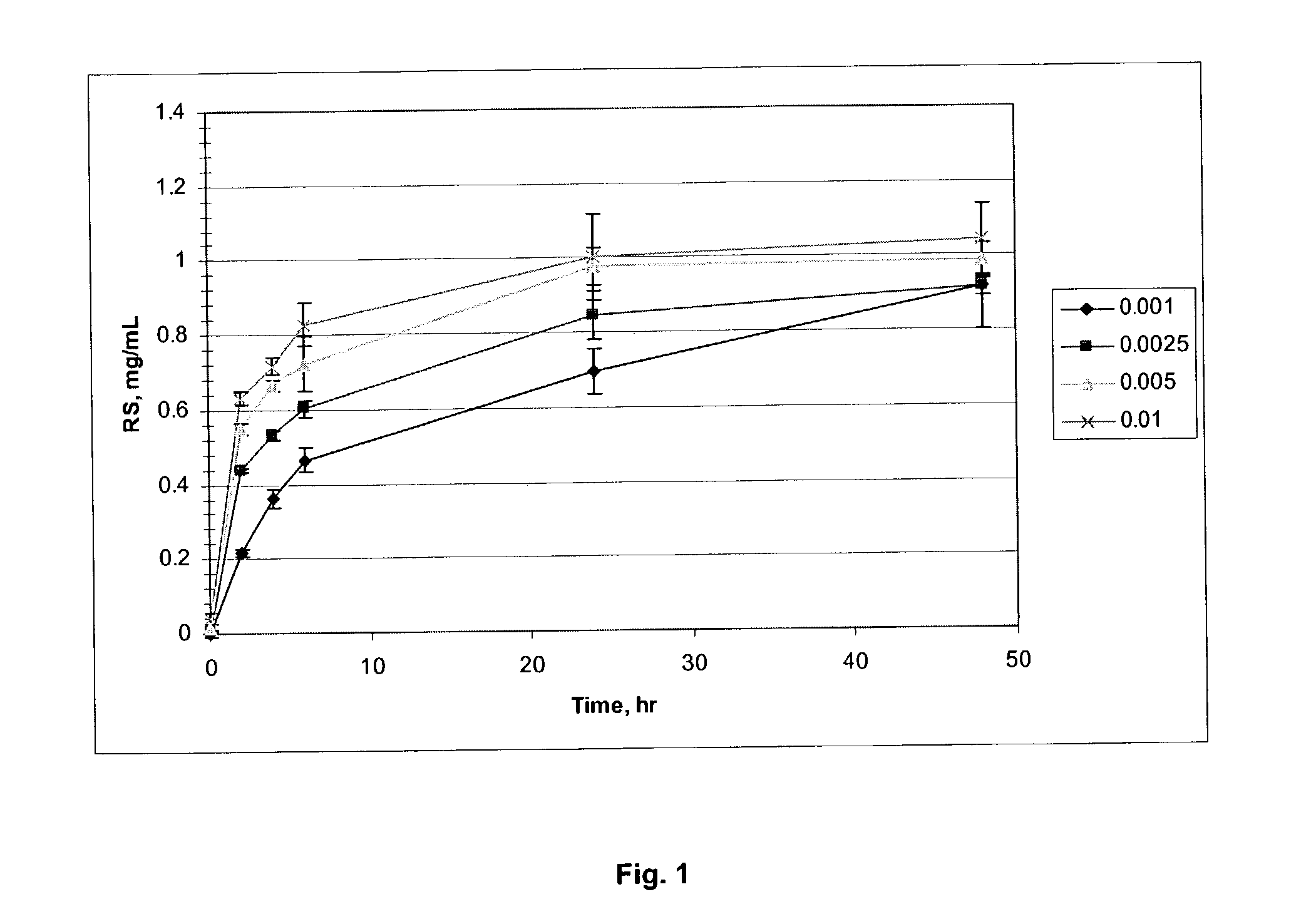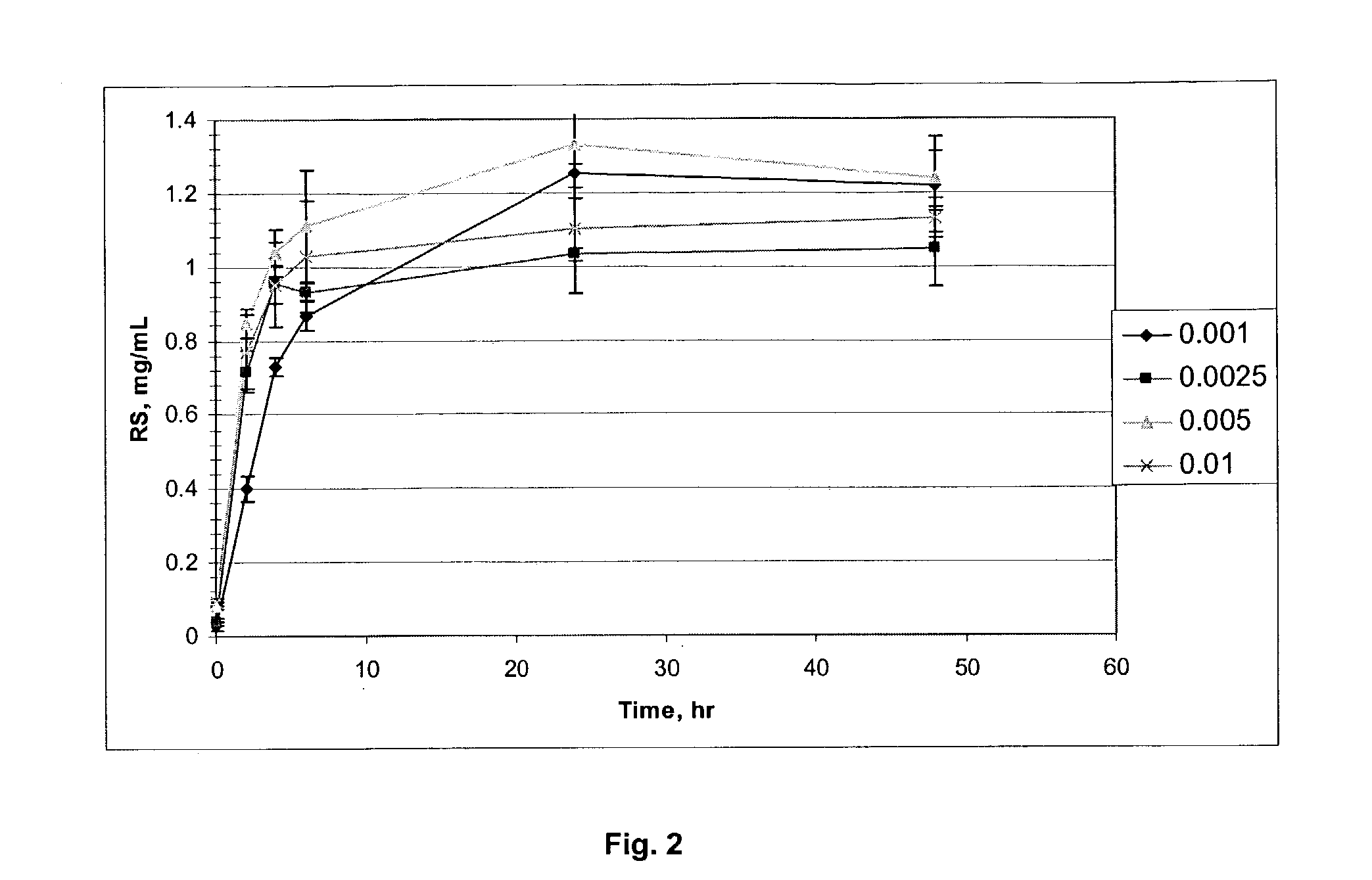Processes for making ethanol
a technology of ethanol and process, applied in the direction of biofuels, fermentation, etc., can solve the problems of increasing the cost of raw materials associated with dry milling, and a relatively low commercial value,
- Summary
- Abstract
- Description
- Claims
- Application Information
AI Technical Summary
Benefits of technology
Problems solved by technology
Method used
Image
Examples
example 1
[0137] Acid Pretreatment of DDG
[0138] Prepare a 10% DS solution of DDG and pretreat in a 1L Parr reactor. The solution is made by weighing out 62.4 g dry weight of DDG, 7.5 g sulfuric acid (72 wt %) and 562 g of water. The final pH is between 1.3 and 1.5. The solids are then heated to 150.degree. C. for 10 minutes. The resulting slurry is washed in a buchner funnel filtration system until the solution in the vacuum flask reaches pH of 4.5. The acid pretreated DDG is referred to as "PDDG".
[0139] Enzymatic treatment: A 20 mg / ml solution of the washed pretreated PDDG was then treated with between:
[0140] 0.001-0.01 FPU CELLUCLAST.TM. 1.5L / mg PDDG
[0141] 0.001-0.01 FPU CELLUCLAST.TM. 1.5 / mg PDDG L+0.064 CBU / mg PDDG of NOVOZYM.TM. 188 at a pH of 5.0 up to 72 hours at 32-50.degree. C. A 20 microL sample is removed for RS determination. Reducing Sugar (RS) was determined using the method descried in the "Materials and Methods" section. The result of the test is shown in FIG. 1 and 2
example 2
[0142] Production of Ethanol from Pretreated DDG
[0143] A 15% DS cellulase pretreated PDDG slurry is prepared as described in Example 1 and introduced into shake flasks for LSF fermentation. The shake flasks have a 2:5 medium to flask volume ratio and are equipped with water trap. The pH of the 15% DS PDDG slurry is adjusted to pH 5 with phosphoric acid. Ethanol Red yeast is propagated aerobically at 500 rpm and 32.degree. C. for 8 hours with 0.02% DS NOVOZYM.TM. 50006 (protease). SP 288 (fungal acid alpha-amylase), 0.8 AFAU / g DS, SPIRIZYME.TM. FUEL (glucoamylase), 2 AGU / g DS and yeast propagate are introduced into the slurry immediately before filling the shake flasks. The fermentation is carried out at 32.degree. C. for 64 hours. The ethanol percentage is determined by HPLC and compared to DDG fermentation (Control).
example 3
[0144] Production of Ethanol from Pretreated DDG Via an SSF Process
[0145] A mixture of 240 grams of corn mash and 10 grams PDDG is prepared and introduced into 500 ml shake flasks for fermentation equipped with a trap. The pH of the slurry is adjusted to pH 5 with phosphoric acid. Ethanol Red yeast is propagated aerobically at 500 rpm and 32.degree. C. for 8 hours and 0.02% DS NOVOZYM.TM. 50006 (Protease). SP 288 (fungal acid alpha-amylase), 0.8 AFAU / g DS, SPIRIZYME.TM. FUEL (Glucoamylase), 2 AGU / g DS and yeast propagate are introduced into the slurry immediately before filling the shake flasks. The fermentation is carried out at 32.degree. C. for 64 hours. The ethanol percentage is determined by HPLC and compared to a corresponding fermentation comprising 240 grams of corn mash in a 500 ml shake flask (control).
PUM
| Property | Measurement | Unit |
|---|---|---|
| temperature | aaaaa | aaaaa |
| temperature | aaaaa | aaaaa |
| temperatures | aaaaa | aaaaa |
Abstract
Description
Claims
Application Information
 Login to View More
Login to View More - R&D
- Intellectual Property
- Life Sciences
- Materials
- Tech Scout
- Unparalleled Data Quality
- Higher Quality Content
- 60% Fewer Hallucinations
Browse by: Latest US Patents, China's latest patents, Technical Efficacy Thesaurus, Application Domain, Technology Topic, Popular Technical Reports.
© 2025 PatSnap. All rights reserved.Legal|Privacy policy|Modern Slavery Act Transparency Statement|Sitemap|About US| Contact US: help@patsnap.com



